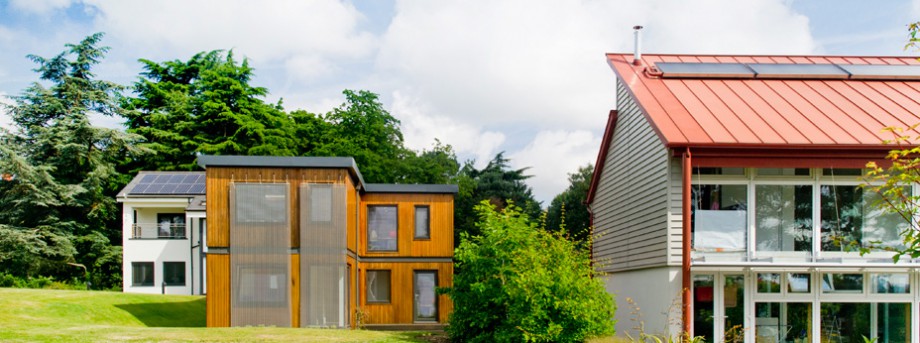The University of Nottingham
 Exchange online
Exchange online
Research Exchange
Zero carbon HOUSE designed and built by students comes home

Design and construct a low cost, zero carbon, family starter home, transport it to Spain, build it, landscape it and open it to the public. On Wednesday June 25 2014 the Nottingham HOUSE (Home Optimising the Use of Solar Energy) came home. It will officially took pride of place on Green Close – a ‘living lab’ of seven eco-homes on University Park.
That was the challenge faced by a group of students from the Department of Architecture at The University of Nottingham when they agreed to enter the first ever Solar Decathlon Europe in 2010. Mark Gillott, Professor of Sustainable Building Design, said: “It was one of the toughest challenges we have ever set our students and they excelled, winning praise from the competition judges for the building’s sustainability credentials.”
With the support of Saint-Gobain, their industrial partner, The University of Nottingham student and staff team were the only UK team brave enough to enter this international competition. The architecture students became the first in the country to design and build a zero carbon house as part of their degree course for this prestigious competition.
The Nottingham HOUSE is based on German Passivhaus standard. With its heavily insulated building fabric, well considered use of glazing, good day lighting and optimised solar gains, the Nottingham HOUSE requires minimal energy for space heating. It has been specially designed to work as part of a terrace, as courtyard housing or as a semi-detached property. The offsite prefabricated modular design makes it easy to construct – in fact, in Madrid the HOUSE was built in a week.
The Solar Decathlon legacy
The house was exhibited in London at EcoBuild 2010 before being shipped across the channel to Madrid for the Solar Decathlon Europe 2010. After the competition it had to be dismantled and brought all the way back again. Over the last few months it has been adapted for the UK climate and is now permanently sited on Green Close as part of the Creative Energy Homes Project.
The result of this extraordinary journey provides an exemplar ‘zero carbon’ solution, that is a viable, repeatable, family home suitable for the UK housing market of the future. It will also play a key role in future teaching and learning and research studies.
Professor Gillott said: “Not only will the Nottingham HOUSE act as a research test bed but also as a teaching and learning facility to inform people about energy saving and renewable energy technologies.”
Official opening
Some of the students who were involved in the project are convinced they’ve secured jobs as a result of being involved in the project. Others graduate this year.
Today many of those students were reunited for the official opening.
Among the other guests attending the official opening are:
Ian Orme, ambassador from the UK Zero Carbon Hub, the UK body overseeing the delivery of zero-carbon buildings in the UK, and Manager of the Sustainable Construction Group. Ian said: “The Nottingham HOUSE is a good example of how the Fabric Energy Efficiency Standard (FEES) can be met cost effectively and provide a viable, repeatable design for low-cost, low-energy.”
Mike Chaldecott, Managing Director of British Gypsum and Chair of the Saint-Gobain Habitat Group said: “The Nottingham HOUSE project represents the importance of industry and academia working together to overcome some of the most challenging issues faced by the housing market today. Together, Saint-Gobain and The University of Nottingham have demonstrated how low-energy architecture can lend itself to the mass-market with a versatile and modular design.
“As a company we are committed to delivering sustainable construction solutions that will enable new homes to meet the new FEES standard suggested for the 2016 zero carbon target, Nottingham HOUSE is a great example of this.”
Leave a Reply
Other News

Top prize for quantum physicist
A University of Nottingham physicist has won a prestigious medal from the Institute of Physics for […]

£600,000 donation for UK’s first in-theatre intraoperative brain scanner
An appeal to raise funds for the UK’s first in-theatre intraoperative MRI scanner — which will […]